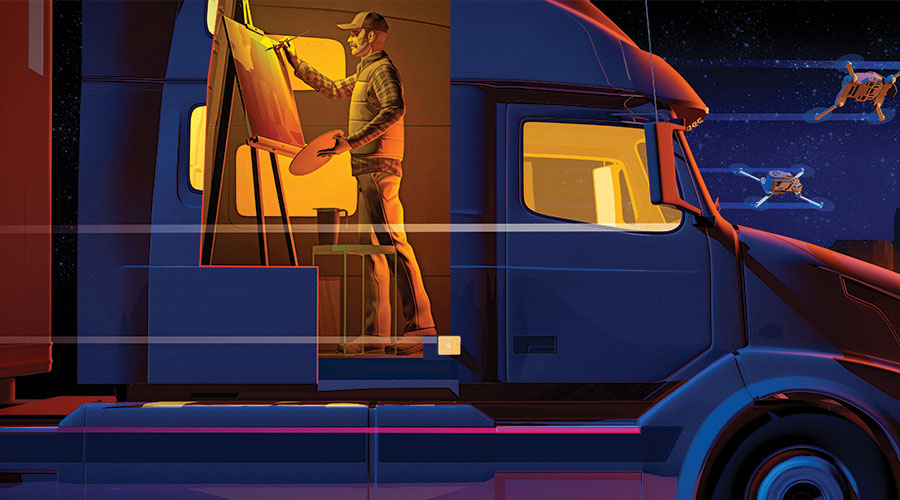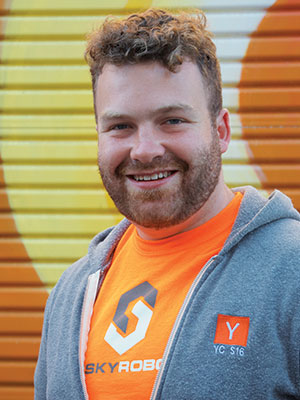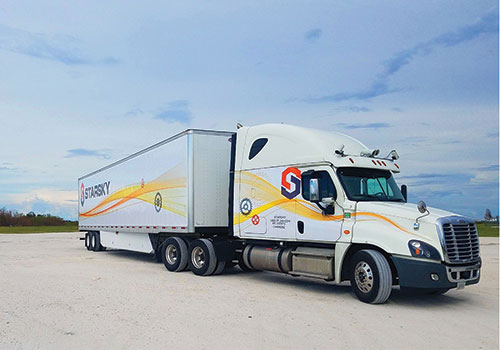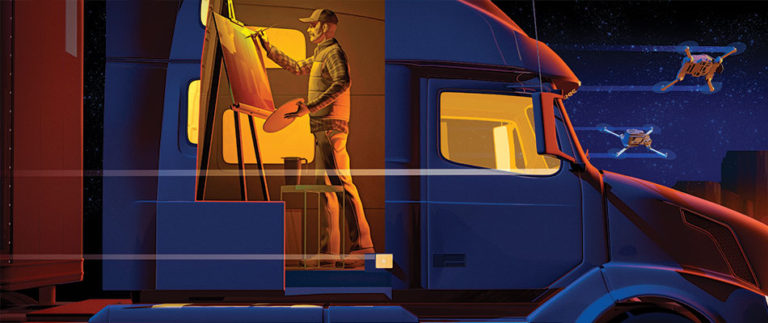
Stefan Seltzaxmacher ’12 isn’t afraid to dream big.
The cum laude lebow business grad is cofounder and CEO of San Francisco-based Starsky Robotics, which has managed, in just a few short years, to put its name alongside Google, General Motors, Tesla and Uber in the conversation about self-driving vehicles. But Seltz-Axmacher doesn’t just want to be part of the conversation; he wants to change it. Along with a team of 65 employees, he is focused on putting driverless long-haul trucks on the road — trucks that he says will make America’s highways safer and solve the trucking industry’s labor shortage. He spoke with Drexel Magazine about trucking, robotics and the wild world of startups.

Q: What makes Starsky Robotics different from all the other companies trying to build a self-driving vehicle?
A: The way we differentiate ourselves is in how we’re thinking about the problem. Most of the teams in this space are working on machine learning and deep learning models that are in a vehicle that will eventually drive itself. What we’re doing is making trucks drive without people in them, while still having a driver’s input. Our trucks will be autonomous on the long stretches of highway, but remote controlled by a person sitting in a central office during the more challenging parts of the trip at the beginning and end.
We started off looking to solve the long-haul truck driver shortage. During my first co-op at Drexel I worked for a company called Southco that was a supplier for Mack Trucks with a factory in Allentown. Since trucking is a commoditized service, there’s downward pressure on how much you can charge for it, which translates into a cap on how much you can pay your drivers. That cap isn’t sufficient to get people to drive a truck for a month at a time, and there’s a shortage of people willing to do it because it’s long hours, it’s extremely hard and it’s lonely, with long stretches away from family and friends.
If we made trucks remote controlled we could provide drivers with meaningful employment opportunities where they can utilize years of experience while remaining close to their homes and families. In addition, our use-case has the potential to relieve downward pressure on wages, increase safe driving practices and reduce driver turnover. This makes us more pro-driver than other companies; our business model makes it possible to employ truckers and send them home every night.
Q: What milestones has your company achieved so far?
A: We’ve raised $21.7 million to date, which is quite a shocking number to see in a bank account app on your phone. To our knowledge, we’re the first people to move stuff for money with a street-legal vehicle that has no one behind the wheel. That was in August 2016. We were paid to move trailers around a truck yard. In January 2017 we first hauled freight on a highway. We started doing that regularly for money in March of that year. We first started doing end-to-end trips where the person in the vehicle wasn’t needed for any of it in December 2017, and in February 2018 we first did a fully unmanned trip, on a closed-down road.
Q:What’s it like to be working in a field where you’re competing with some of the biggest tech and car companies in the world?
A: They aren’t competition because nobody is doing anything commercially yet. It’s all still experiments and demonstrations, even at Google where they’ve been at it for 13 years. So it’s actually a level playing field. It’s a race, and I think we’re winning that race.
There really is something to specialization. If you’re a large company you can throw a thousand things up against a wall and if 10 of them stick you’ve had a really good year. As a small company you can only throw one thing and that thing has to stick. We’ve been able to be very thoughtful and very deliberate with what we’re going after in a way that the larger companies haven’t had the pressure to do. The value of focus to a specific problem is a force multiplier that often allows you to compete and win against organizations with a thousand times the manpower.
What Google started off trying to do is build a car that could drive everywhere all the time in any conditions, and that’s really hard. Driving in the snow is really hard, driving in West Philly is hard, driving on the Pennsylvania Turnpike is hard, and they’re all hard in slightly different ways. So trying to build something like that out of the gate is really difficult and requires decades to craft.
At Starsky our hard problems are that we need to make teleoperations work, and we need to make robotics work, and that’s it. Starsky trucks drive autonomously on highways under known weather, lighting and traffic conditions. When the trucks get off the highway or the conditions change, our highly skilled remote drivers take control of the vehicles.
Q: How did your time at Drexel and your co-ops help you understand the trucking and robotics industries?
A: My second co-op was a safe choice, and it made me pretty miserable. I worked as a paralegal filing paperwork to sue poor people. That made me pretty adverse to making safe decisions. I ended up for my third co-op doing a study plus co-op abroad in Singapore at a startup. Because I was hardworking and had ideas, even though I was a co-op, I was able to get a position where I was managing other interns.
Because of the chaos of a startup, as an intern I was able to do big stuff and that was very attractive to me. After I graduated I spent a summer in Boston increasing my startup skills and moved out to San Francisco in September 2012. I only started digging into this idea of driverless trucks as a thing to do in 2015.

ROBOTS ON THE ROAD. To date, Starsky Robotics has raised $21.7 million and currently employs 65. The company conducted its first fully unmanned driving trip on a closed road in February 2018. Says Seltz-Axmacher: “[There isn’t] competition because nobody is doing anything commercially yet.”
Q: What sparked your desire to start this company?
A: I was on a road trip with a friend who was into robotics and we were brainstorming ideas for his next robotics project. There were a lot of trucks on the road and I thought, “What if we made trucks remote controlled?” It was one of those ideas that as I started digging into it became a better and better and better idea. There are all of these articles about self-driving cars and they’re like, “Obviously trucks will be first,” but nobody was working on self-driving trucks, so I thought, “Maybe I can.”
Q: What about the trucking industry makes it ripe for automation?
A: A fundamental impetus for robotics in general is places where there are labor shortages. Robots as a broader area are really expensive, way more expensive than anyone ever thinks they’re going to be. They’re hard to make and harder to make reliable. A robot has to be able to create quite a bit of value to justify how much it costs in R&D, let alone actual funding. We’re defining a robot as something that senses, something that thinks and something that has to move in the physical world.
Our system is doing the work of two-and-a-half people who you can’t hire enough of, but if you could, you would pay each of them $90,000 a year.
Q: What have been the biggest challenges so far?
A: With startups, your default state is dead. Many things can kill you at any point and they are compounding in complexity. So everything about having a startup is hard. To start off with, the autonomous space is a weirdly dogmatic space. Even though no one has ostensibly done anything — there aren’t self-driving cars — there’s a relatively exclusive clique of people who’ve been working on this for 15 years, and those people have been able to raise disproportionate amounts of money because they’re experts, but they’re essentially experts in not getting the job done. So fundraising for us was very hard, until we got into Y Combinator.
So, getting initial credibility was hard. Because of how differently we see the world from other startups, we have to always be selling our worldview for how this will happen and how these things will work. We have to make that point all the time to people who are ostensibly well read and intelligent in this space.
Q: How far away do you think we are from truly autonomous vehicles being commonplace on our roads?
A. I think autonomous trucks are going to be here very soon. We’re going to make that happen. I don’t know what’s going to happen with self-driving taxis, though. I think we’re in the beginnings of a very bad year for that industry. There’s a lot of money going in and not a lot of progress coming out.
Of course, creating a seamless national regulatory structure for self-driving trucks is critical to ensuring their safety and further development. Today, the rapid development of AV technology is outpacing the development of corresponding regulation. We work closely with relevant legislative and regulatory entities to ensure compliance with all the requirements and regularly consult law enforcement agencies to help develop best practices.
Q: What do you say to people who worry about the safety of sharing a road with driverless cars?
A: Most people have a story about a time when a truck driver nearly killed them. We have 40,000 people who are dying every year on the roads. And truck drivers are way more likely than other drivers to cause vehicle accidents. The way that the trucking industry is set up is such that it makes it really hard for there not to be a lot of accidents.
Truck drivers are only paid per mile that they haul freight, so if they’re stuck in traffic they’re not making money. They have to take bathroom breaks while they’re still moving. If a truck driver has self-identified as being tired and needing to go take a nap, they may not be able to find parking because there’s a shortage of parking spots for trucks, so drivers who have said “I’m no longer safe to drive” might have to drive for a couple more hours.
We think that exit-to-exit highway automation combined with well-trained and well-rested remote drivers will make the roads fundamentally safer. By getting a person out of the cabin we can significantly reduce accidents that are attributed to human error.
Q: Trucking is a $700 billion industry in the United States. If you’re able to deliver on your vision, how big is the market potential?
A: Europe’s market is about the same size as America’s and the rest of the world is double that. So probably it’s $3 trillion a year in revenue worldwide. We should quite easily be able to be an ExxonMobil-size company, a hundreds-of-billionsof-dollars-a-year organization.
Q: What motivates you as an entrepreneur?
A: This is the coolest thing I’ve ever done, by far. Between co-ops and work after college, I’ve had quite a number of different jobs, and nothing has ever used every corner of my being, every corner of my personality, every random tidbit of what I know. Nothing else I’ve ever done has ever called on all of that so frequently that I’ve been so incredibly engaged. And that’s really cool. We have the opportunity to build a world-changing organization, and along the way I have the opportunity to make drivers’ lives better, to work with really smart, dedicated people, and to reach something that approaches self-actualization.



